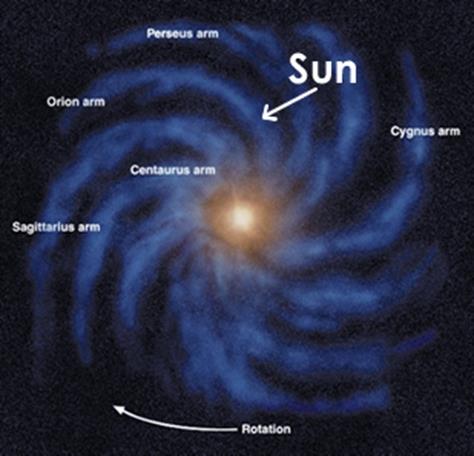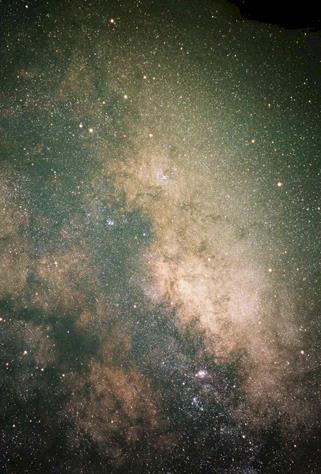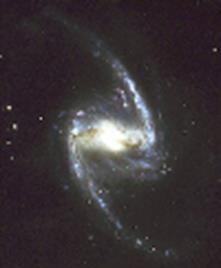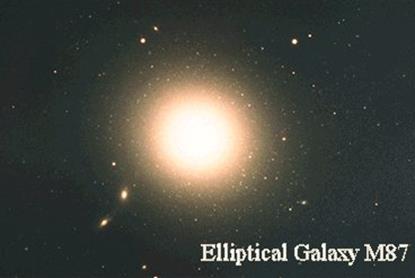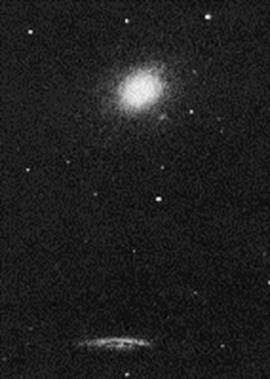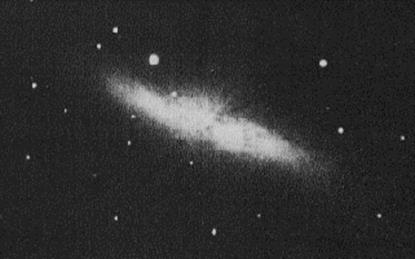GALAXIES
![na01826_[1]](SCI180U04Galaxies_new_image003.png)
Unit Overview
This
unit will explore the formation of galaxies and the system used by scientists
to classify galaxies.
|
GLOSSARY OF KEY
TERMS |
|
universe:
is everything that exists, including objects and energy, throughout
time and space. |
|
galaxy:
a system of about 100 billion stars. Our Sun is a member of the Milky
Way Galaxy. There are billions of galaxies in the observable universe.
Exactly when and how galaxies formed in the Universe is a topic of current
astronomical research. |
|
spiral galaxy:
a galaxy consisting of a flattened rotating disk of young stars, a
central bulge of generally older stars, and a surrounding halo of older stars
and dense clusters of old stars called globular clusters. The disk is
prominent due to the presence of young, hot stars in a spiral pattern |
|
dust lane:
a lane of dark, obscuring interstellar dust in an emission nebula or
galaxy. |
|
primeval:
having existed from the beginning; in an earliest or original stage or
state. |
|
elliptical
galaxy: a galaxy whose structure shaped like an
ellipse and is smooth and lacks complex structures such as spiral arms. |
|
interstellar material: the gas and dust between stars |
|
irregular
galaxy: a galaxy with no spiral
structure and no symmetric shape. Irregular galaxies are usually filamentary
or very clumpy in shape |
|
astronomer: a scientist who studies the stars and
space. |
|
Big Bang Theory: the theory that the Universe began with all
matter and energy concentrated to very high density and temperature some 15
billion years ago. The present universe expanded from that epoch and is still
expanding.. |
|
lenticular galaxy:
a galaxy that is shaped like a lens. They are of an intermediate type
between an elliptical galaxy and a spiral galaxy |
|
Milky Way
Galaxy: the large spiral galaxy in which our Sun
and planets reside. Our Sun is one star of several hundred billion in the
Milky Way |
Print out the Key
Term worksheet for extra practice. Key Term Worksheet
Galaxy Formation
One
of the most amazing experiences that takes no money and a little bit of time is
star gazing. It’s not as easy to do as in the past because of light pollution.
Light pollution? That is the light caused by cities, street lights, etc. that
can block the beautiful night sky full of stars. But your first assignment in
this unit is to take one evening this week and spend some time looking at the
night sky. Try to find a place where there is little or no man-made light so
that you can have your best view. If you have binoculars or a telescope take
them with you, but even with the naked eye, you will see some amazing sights.
Look for the brightest lights, look for areas of clusters of light and if
you’re lucky enough to be out when the moon is present, take some time to look
closely at it too. Stay as long as the weather permits, and then when you go
back inside write down your observations and thoughts.
In
the days before electricity and video games, night time entertainment was often
sky gazing. And man has wondered from the beginning of time a series of
questions: “What are those lights?”, “How did they get there?”, “How long have
they been there?”, and “How do they affect us?” Early scientists began to write
down observations and record the motion of these heavenly bodies. Names were
given to the star groups and humans did their best to invent technology to help
study and understand outer space. Today, there is a great deal of information
that has been compiled and still more is revealed to us daily by new telescopes
and space probes. Let’s take a look at the current theories that scientists
have about the formation of the universe
and the heavenly bodies called galaxies.
The
Big Bang Theory: First you must
remember that a theory is a well-supported explanation of some aspect of the
natural world that explains a certain set of events in nature. The Big Bang Theory is a widely excepted
theory that gives an explanation of the origin of the universe. According to the theory there was a primeval explosion approximately 10 to 20 billion years ago that
brought all time, matter, and energy into existence. Because of the extreme
amount of heat, it is believed that only subatomic particles and radiation
existed. As the universe began to
cool, atoms of helium and hydrogen began to form. Scientists say that the universe is constantly expanding, which
would support the theory of a large explosion and materials moving away from
the explosion. There are other theories of the origins of the universe, but the Big Bang Theory is the most complete and widely accepted of the
theories.
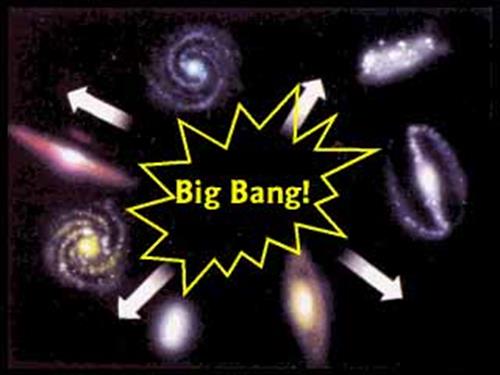
Galaxy Formation: A galaxy is a large system of stars and interstellar material. Each galaxy contains millions of stars and
each star may be millions of times larger than our sun. Scientists estimate
that there are over 100 billion galaxies in the universe. There are two major thoughts on how the galaxies formed.
Some astronomers believe that the universe built up from small pieces
like dust clouds and star clusters to form larger formations like galaxies.
Other astronomers believe that the universe formed large chunks or lumps
of matter after the Big Bang that eventually broke down into smaller groups of
matter like galaxies. Astronomers
today still search for the answer and that area of science is still very new.
Technology is continuing to grow and gives us new answers and new puzzles. As
you look at the picture below, you can see that galaxies come in all sizes and
shapes, which is how scientists classify them. It is time to take a look at the
different types of galaxies.
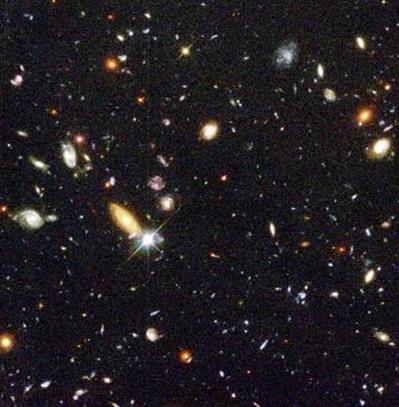
Galaxy
Classifications
The
best known classification system used to organize galaxies was developed by
Edwin Hubble. This system classifies the galaxies by their shape into three
broad classes. These classes are spiral
galaxies, elliptical galaxies
and irregular galaxies. Scientists believe that galaxy shape was influenced by their relative gas content, star
formation history, and their internal motions.
Edwin Hubble: (1989-1953) Much
of Edwin Hubble’s work dealt with galaxies. Before his work, it was the
accepted belief that our galaxy was
the only galaxy. His discoveries
about galaxies and our expanding universe
were amazing to the people of the 1920’s and 30’s. He provided some of the
first evidence of the Big Bang Theory.
The largest space-based telescope is named after Edwin Hubble and this
telescope has recorded some of the most amazing photographs in space study
history.
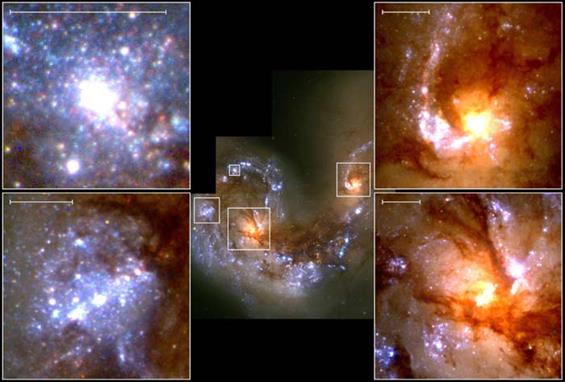
Close-Up of Star
Formation in Antennae Galaxy
These
four close-up views are taken from a head-on collision between two spiral
galaxies, called the Antennae galaxies, seen at image
center. The scale bar at the top of each image is 1,500 light-years across. The
photos were taken by the Hubble Telescope.



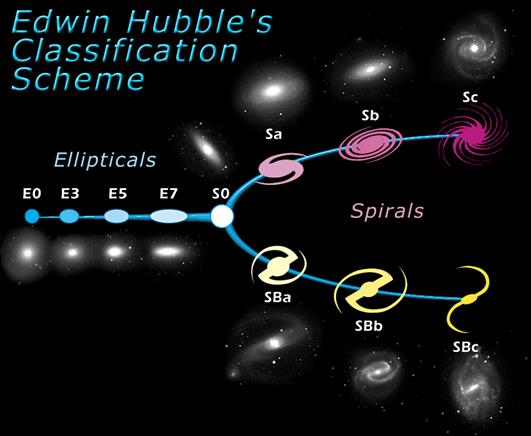
In
the 1920s Edwin Hubble separated galaxies into four general types according to
their appearance elliptical, spiral, barred spiral and irregular and then
classified each into subtypes.
Spiral Galaxies: Two major
characteristics must be present for a galaxy to be a spiral galaxy. There must be a central disk with a dense
concentration of stars surrounded by tightly wound arms and then several spiral
shaped arms extending outward. This type of galaxy generally has a rapid
rotation. More than half of all observed galaxies are classified as spiral. Spiral galaxies are rich in gas and
dust that appears as lanes (dust lanes) or
arms when viewed from above. They also appear bluish due to the large amount of
new stars they contain.
Our
own galaxy is a spiral galaxy and is known as the Milky Way Galaxy. Our solar system is located on one of the arms of
the Milky Way. Looking at the night sky, you may see a band of stars and fuzzy
light. What you see is the center of our galaxy. It is hard for us to get a
clear view because of the distance and the large amount of interstellar dust
that blocks the view. This interstellar
material provides matter for new stars to form. Below is a chart of the Milky Way galaxy with our Sun labeled
on the Orion arm. As you can see, some of the other arms of the galaxy are also
named. The arms of a spiral galaxy are very active star forming areas.
|
|
|
Below
is a photograph of our view of the Milky Way in the summer sky. The brighter
cluster of light in the middle is the center of our galaxy. |
|
|
|
A
sub-category of spiral galaxies is
the barred spiral galaxy. A barred spiral galaxy usually has two arms that
extend out from opposite sides of the central disk. This type of galaxy has a
straight bar of stars, dust, and gas from which the two arms extend. |
|
|
|
Elliptical
Galaxies: These galaxies are elliptical (oval) in shape, have no disks,
spiral arms, or dust lanes and
contain little or no interstellar
material. The brightest stars in this type of galaxy are red stars, which
indicate that these stars are older and not as hot as blue stars. About
twenty percent of the observed galaxies are elliptical galaxies. |
|
|
|
Lenticular
Galaxies: This type of galaxy is a disk shaped galaxy without any obvious
structures. They are believed to be made up of mostly old stars and the
galaxy has used up all of its interstellar
material. This gives the disk an overall even appearance. They are often
misclassified as elliptical galaxies. If you compare the lenticular galaxy below with the elliptical one above, you can
see that the one below has fuzzier, less circular edges. |
|
|
|
Irregular
Galaxies: Irregular galaxies are those that do not fit the characteristics of
Hubble’s spiral, elliptical, or lenticular type galaxies. There are various
ideas on why they do not have regular shapes, but many scientists believe
their shapes are influenced by the gravitational pull of larger galaxies that
are close by. |
|
|
Unit Summary:
Galaxies
have formed from dust, gas, and interstellar
materials left over from the origin of the universe. The Big Bang Theory is the most widely
accepted origin theory. Classification of galaxies is done primarily by shape.
The classification system was developed by Edwin Hubble and is used by most
scientists today.
Galaxies
are categorized into four major groups: spiral, elliptical, lenticular, and
irregular. Other characteristics of the groups include relative gas content,
star formation history, and the galaxy’s
internal motion.
